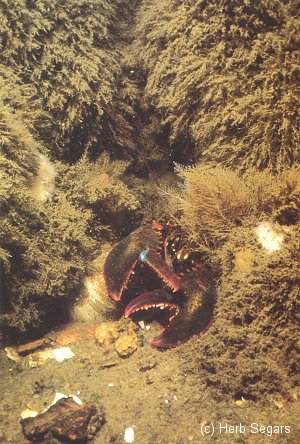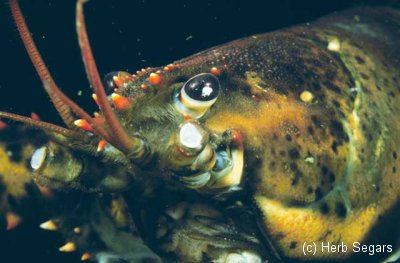American Lobster (6/6)
The North American Lobster
by Herb Segars

The scenario repeats itself over and over again on a daily basis at restaurants throughout the Garden State. Whether it be boiled, steamed, stuffed or in an au gratin sauce, the North American lobster, Homarus americanus, has been the unwilling guest of honor at more seafood dinner parties than almost any other species of underwater life. Yet few people know how the lobster lives, what it eats, or how it survives in the undersea community. Locally, the clawed crustaceans are found in the shallow waters of inlets such as Shark River, Manasquan and Barnegat and on shipwrecks and rock piles in deeper offshore waters.
With its tail In a hole, the North American lobster protects itself with a pair of formidable weapons.
The name lobster arouses thoughts of the rocky shores of Maine as the two have become synonymous over the years. For many years, the prime inshore fishery for lobsters has been from southeastern Labrador to southern New England and primarily in the waters of Maine, Nova Scotia, and the southern Gulf of St. Lawrence. In recent times, the inshore fishery has expanded as far south as Cape Hatteras, with sizable quantities of lobsters being harvested in the submarine canyons off the coasts of New Jersey and Long Island. It is reported that in 1956, a 44-pound North American lobster was hauled from the deep water off eastern Long Island.
The claws of the lobster are its prime weapons; the smaller, slender claw is the feeder or shredder claw and the larger, more massive claw is the crusher claw, capable of doing exactly what its name intimates. Despite these formidable weapons, the lobster is vulnerable from the rear. For protection, it resides in holes in rocky jetties or in shipwrecks.
During the daylight hours, lobsters are found in their usual positions, facing the entrance to their lairs with claws at the ready and antennae swaying to and fro like an underwater radar detection system, retreating at the slightest movement. It would be a reasonable assumption that the lobster's large eyes sensed the movement and provoked the quick reaction. The eye of the lobster is very similar to that of a fly. It is compound, made up of thousands of tiny facets or little eyes which are extremely sensitive to light, as evidenced by the lobster's nocturnal roaming habits. Although very sensitive, sight seems to be the lobster's poorest sense. As compensation, Mother Nature has bestowed on the crustacean other sensory devices to alert it to impending danger.
These functions are similar to smell, hearing and touch, and are honed to a high degree of sensitivity. On nearly every part of the lobster's body are tiny hairs that sense movement in the water and transmit the data to the lobster's nervous system, much the same way the human ear senses sound waves in the air stream. This same sensory system is used in orientation and navigation. Hairs on the tips of its legs provide the lobster with information about the terrain it is traversing. In many ways. The lobster operates as a blind person would, feeling its way over and around many irregularities on the ocean bottom. While hearing and touch are recorded by the tiny, bristle-like hairs, the lobster's keenest sense is that of smell. It accomplishes this through tiny chemical receptors on various parts of its body. Remaining down current, the lobster samples the water for scents of enemies or possible food sources and reacts quickly to information. Lobsters even communicate with each other by releasing chemicals into the water.
One of the interesting capabilities of the lobster is its ability to shed a claw at will. This occurs near the second or double joint, where the claw is the smallest. This happens during molting if the lobster has difficulty withdrawing from the claw and also when threatened by an enemy. The rejuvenation process proceeds quickly and within three molts, the claw will have been regenerated to its formidable former self.

The lobster's diet consists of clams, mussels, snails, marine worms, seaweed, starfish and fish when they can be captured. One of the favorite meals of the lobster is the rock crab, Cancer irroratus. This crab is a feisty little fellow who will rear up and defend itself when threatened. This fighting position, although brave, provides the lobster with many flaying appendages to grapple. In contrast, a close relative of the rock crab, the Jonah crab, Cancer borealis, is not favored by the lobster. When threatened, the crab will tuck in its appendages and settle into the bottom, giving the lobster very little to grasp.
It is very difficult to predict the age of a lobster because its growth rate depends on salinity, availability of shelter, frequency of regeneration, water temperature and food - the latter two being the most important factors affecting growth and weight gain. Scientists have estimated that the typical lobster found in a restaurant or seafood store, weighing about 1 to 1 1/2 pounds, is between six and eight years old.
Determining the sex of a lobster is accomplished by turning the crustacean over and looking at the first set of swimmerets on the tail. These appendages are found directly to the rear of the last set of walking legs. On the female, the swimmerets are soft and feathery while the male displays hard and bony projections.
Besides codfish, man is the major predator of lobsters. The current lobster laws in the Northeastern states require that a lobster be at least [ see regulations ] inches in length from the end of its eye socket to the beginning of the tail before it can be kept. Studies have shown that female lobsters are not ripe for mating until they reach a length of three and three-quarter inches. Harvesting of immature females may be the cause for the decrease in the average size of commercially caught lobsters over the last few decades. More laws are being introduced each year to control the numbers and sizes of lobsters that can be taken.
The North American lobster is an entrenched member of our culinary heritage and must be harvested in a responsible manner in order for our descendants to enjoy this clawed crustacean. Remember that the North American lobster comes from the waters of our own state. When somebody says "that was a wonderful Maine lobster, " smile ... and let them in on our secret.
This article first appeared in New Jersey Outdoors - July / August 1988



